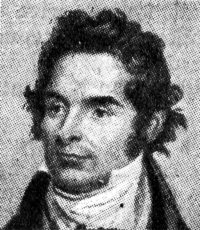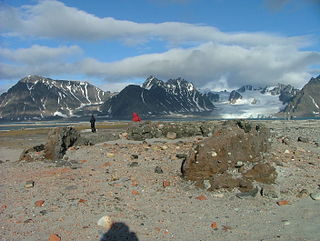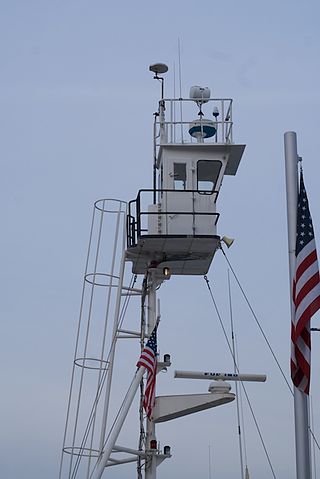
In physical geography, a fjord or fiord is a long, narrow sea inlet with steep sides or cliffs, created by a glacier. Fjords exist on the coasts of Antarctica, the Arctic, and surrounding landmasses of the northern and southern hemispheres. Norway's coastline is estimated to be 29,000 km (18,000 mi) long with its nearly 1,200 fjords, but only 2,500 km (1,600 mi) long excluding the fjords.

William Scoresby was an English whaler, Arctic explorer, scientist and clergyman.

Smeerenburg was a whaling settlement on Amsterdam Island in northwest Svalbard. It was founded by the Danish and Dutch in 1619 as one of Europe's northernmost outposts. With the local bowhead whale population soon decimated and whaling developed into a pelagic industry, Smeerenburg was abandoned around 1660.

Scoresby is a suburb in Melbourne, Victoria, Australia, 29 km east of Melbourne's Central Business District, located within the City of Knox local government area. Scoresby recorded a population of 6,066 at the 2021 census.

Scoresby Sound is a large fjord system of the Greenland Sea on the eastern coast of Greenland. It has a tree-like structure, with a main body approximately 110 km (68 mi) long that branches into a system of fjords covering an area of about 38,000 km2 (14,700 sq mi). The longest of the fjords extends 340–350 km (210-216 mi) inland from the coastline. The depth is 400–600 m (1,310-1,970 ft) in the main basin, but depths increase to up to 1,450 m (4,760 ft) in some fjords. It is one of the largest and longest fjord systems in the world.
David Buchan was a Scottish naval officer and Arctic explorer.

A crow's nest is a structure in the upper part of the main mast of a ship or a structure that is used as a lookout point. On ships, this position ensured the widest field of view for lookouts to spot approaching hazards, other ships, or land by using the naked eye or optical devices such as telescopes or binoculars. It should not be confused with the top, the platform in the upper part of each lower mast of a square-rigged sailing ship.
Stefansson Bay is a bay indenting the coast for 16 kilometres (10 mi) between Law Promontory and Fold Island. Mawson of the British Australian New Zealand Antarctic Research Expedition (BANZARE) applied the name to a sweep of the coast west of Cape Wilkins which he observed on about February 18, 1931. Exploration by DI personnel on the William Scoresby, 1936, and the Lars Christensen expedition 1936–37, defined this section of the coast more accurately. It was named for Vilhjalmur Stefansson, Arctic explorer.

James William Slessor Marr was a Scottish marine biologist and polar explorer. He was leader of the World War 2 British Antarctic Expedition Operation Tabarin during its first year, 1943–1945.

Kongsfjorden is an inlet on the west coast of Spitsbergen, an island which is part of the Svalbard archipelago in the Arctic Ocean. The inlet is 26 km (16 mi) long and ranges in width from 6 to 14 km. Two glaciers, Kronebreen and Kongsvegen, head the fjord.

Milne Land or Milneland is a large island in eastern Greenland. It is the third largest island of Greenland, after the main island of Greenland and Disko Island. It is named after British admiral David Milne.
The Scoresby Hills, also called the Scoresby Mountains, are a mountain range on the east coast of Bathurst Island, Nunavut, Canada. It consists of low hills which in turn form part of the Arctic Cordillera mountain system.
The Darling Peninsula is located on the eastern coast of Ellesmere Island, a part of the Qikiqtaaluk Region of the Canadian territory of Nunavut. It stretches eastward into Nares Strait, north of Dobbin Bay. Mount Stevens lies in the center of the peninsula, Scoresby Bay is found on its central coast, and Cape Louis Napoleon is located at the end of the 32 km (20 mi) long peninsula.
Captain Jack is a 1999 British comedy film produced by John Goldschmidt and written by Jack Rosenthal. The cast includes Bob Hoskins, Sadie Frost, Gemma Jones, Anna Massey, Peter McDonald, Maureen Lipman and Michele Dotrice. The film was produced by Goldschmidt's own company Viva Films Ltd. and was distributed on video by Koch Vision.

RRS William Scoresby was British Royal Research Ship built for operations in Antarctic waters. Specially built for the Discovery Committee by Cook, Welton & Gemmell of Beverley, the ship was launched on 31 December 1925, and named after the noted 19th-century Arctic explorer, scientist and clergyman. Over the next 12 years the ship made seven voyages into Antarctic waters as part of the Discovery Investigations, accompanied by the ship Discovery until 1929, and then by Discovery II. During this time she marked about 3,000 whales and completed biological, hydrographical and oceanographic studies. She also took part in the 2nd Wilkins-Hearst Antarctic Expedition in 1929-1930, launching a Lockheed Vega floatplane for flights over Antarctica.
Scoresbyøya is an island in the Svalbard archipelago, north of Nordaustlandet. It has an area of about 6 km², and is located in Nordenskiöldbukta, outside the bay of Sabinebukta. The island is named after Arctic explorer William Scoresby. The southern part of the island is dominated by a large lagoon and narrow sand banks.

Eggøya is a peninsula of Jan Mayen island of the Arctic Ocean. It is located on the southern side, in the central part of the island, east of Sørlaguna, and defines the northeastern extension of the bay Rekvedbukta. To the west of the peninsula is the bay Eggøybukta, and to the east is the bay Jamesonbukta. The highest peak at the peninsula has a height of 217 m.a.s.l. Eggøya consists of the northern part of an old volcanic crater, and small hydrothermal vents are still present. The outer part of the peninsula forms the semicircular bay of Kraterbukta, facing south-southeast with steep slopes. To the south of the peninsula is a small islet, Eggøykalven.

Antarctic Haven is a bay in King Christian X Land, Northeastern Greenland.












